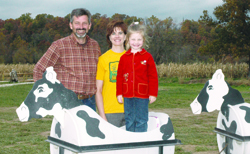Finding Money in Corn Mazes
by November 16, 2011 4:21 pm 352 views

Rod Wallis opened Northwest Arkansas’ first commercial corn maze in 2010, several years after seeing a segment about the industry on CNN.
“That just kind of planted a seed,” said Wallis, who, along with his wife, Kate, operates Ozark Corn Maze in Cave Springs.
Fast-forward to this fall, and two primary competitors have sprouted in the area. Farmland Adventures in Springdale and Huck’s Corn Maze in Lowell joined in the bid for profits in the fast-growing maze marketplace.
Neither Wallis nor Farmland’s Dwain Parsons were willing to disclose specific revenue figures, and attempts to contact Huck’s owners were unsuccessful. Still, varied reports from across the country indicate six-figure gross revenue totals at some corn-maze operations.
Hugh McPherson, who started Maize Quest Fun Park in New Park, Pa., 15 years ago, said the variance in estimates largely is due to a wide range in pricing.
“Somebody in New Jersey might charge 15 dollars a head, while the Parsons are probably charging more like seven dollars a head,” said McPherson, who has done maze consulting work for 13 years, including time spent at Farmland earlier this year.
“But there’s no doubt this is a diversified revenue stream for people with farmland. Right now, I’d guess this is supplemental income for the Parsons, but in a year or two, they could be able to eliminate an off-the-farm job.”
Parsons, who works for the City of Fayetteville Water Department, didn’t shoot down that notion.
“If you would’ve asked me two years ago if I was going to be in the corn maze business, I would’ve said, ‘No way,’” Parsons said. “But in 12 months, we went from nothing to this.
“Now this is our plan, that we’re going to get bigger and better next year and keep on growing.”
Growing Profits
Wallis has growth plans, too. He started OCM with what he deemed “a pretty minimal” initial investment, and built the permanent structures that dot the landscape and signify Wallis’ long-haul plans. Handling his own construction projects not only reduced his costs, but also was a natural move.
“At the time, I was building houses … maybe 40 or 50 a year, and I just didn’t have time to mess with it,” Wallis said of watching the CNN segment. “When that business dramatically changed, Kate and I decided to find a way to make it happen.”
The result is an operation that features three mazes, including a haunted version that serves as a nighttime attraction, a petting zoo, pumpkin patch, concession stand and other ancillary activities.
“The maze itself may be what you advertise, but people also want to go pick pumpkins,” Wallis said. “We have corn cannons, we bring in outside vendors.
“We want to try to make it feel more like a fall festival.”
Wallis said both attendance and revenue are up about 10 percent in OCM’s second year.
“It’s not huge, but it’s growth,” he said. “We like this business and it’s a good business revenue-wise.”
The revenue comes not just from admission to the mazes — $7 at OCM and $7-$9 at Farmland — but monies from the pumpkin patches and other available activities. And while Wallis estimated that 10 percent of Northwest Arkansas’ population might attend one of the mazes, Parsons said he’s seen figures ranging from 5 percent to 20 percent.
With a Metropolitan Statistical Area population of more than 435,000, that means admission-only revenue potential of 20,000 to 80,000 people. Parsons, who said his family’s initial investment exceeded $50,000, also said anything near the high end of that range would be more than enough to keep the area’s three major mazes profitable.
“If you divide 80,000 three ways, that’s still almost 27,000 people. If I had 27,000 people, they could have the rest of them,” he said with a laugh.
Wallis isn’t so sure. He thinks attrition will occur, and is working hard to cement OCM as a recognizable brand. Part of that is hosting field trips that can lead to annual outings.
“That’s an important part of the business for two reasons,” Wallis said. “There’s evidence that the kids will come back on Saturday with mom, dad and a sibling, and then it’s also part of building a tradition, a family tradition.”
Parsons strives to earn repeat business, too, and is exploring the possibility of adding attractions and activities that would allow Farmland to stay open about 10 months a year.
McPherson, for example, has incorporated a myriad of activities to make Maize Quest Fun Park a year-round destination. Examples include a bamboo maze that’s operable in every season but winter, and a rope maze that includes more than 1,600 feet of nautical rope forming a path that leads to the deck of a pirate ship.
“We started off as a pick-your-own family farm,” McPherson said, “but farmland has become much more than that.
For now, though, he’s happy with the fact Farmland exceeded its goal of 5,000 customers.
Parsons also believes there’s plenty of money to be shared in corn mazes.
“All the fast-food places are on the same streets, so I don’t know why we can’t all get along,” he said of his competitors. “Pigs get fat, and hogs get slaughtered.”
